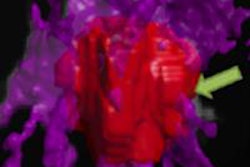Computer-aided detection (CAD) technology doesn't improve the accuracy of mammography and increases a woman's risk of being called back unnecessarily, according to a study released Wednesday in the Journal of the National Cancer Institute.
Lead author Dr. Joshua Fenton, from the University of California, Davis, and colleagues analyzed 1.6 million mammograms in seven states to determine whether CAD helps find breast cancer. They found that the use of mammography CAD was associated with statistically significant lower specificity and positive predictive values, and the sensitivity for invasive breast cancers was similar whether or not CAD was used (JNCI, July 27, 2011).
The study was conducted under the auspices of the national Breast Cancer Surveillance Consortium, which is funded by the National Cancer Institute.
CAD for breast imaging was approved by the U.S. Food and Drug Administration in 1998, and its use has proliferated since Medicare began covering it in 2001. The technology is now applied to a large majority of screening mammograms in the U.S., with annual direct Medicare costs exceeding $30 million, according to a 2010 study in the Journal of the American College of Radiology.
The findings published July 27 follow an initial effort by Fenton and colleagues to assess the technology that was published in the New England Journal of Medicine in 2007. In that controversial study, the researchers examined mammography screening results in 43 facilities, including seven that utilized CAD, and found that CAD was associated with reduced accuracy of interpretation of screening mammograms but no difference in the detection rate of invasive breast cancer.
"Our earlier study results raised concerns that CAD might increase the chances that women would be recalled for further testing without clear benefits of cancer detection," Fenton told AuntMinnie.com. "But this earlier study was done during the initial period of CAD adoption with a small number of facilities, and we didn't look at breast cancer stage or size or other issues related to prognosis. We did this larger study with a larger and more contemporary sample of mammography facilities to examine those issues and re-evaluate those findings."
For the current study, Fenton's group examined screening mammograms performed on more than 680,000 women at 90 mammography facilities in seven U.S. states from 1998 to 2006. Of these 90 facilities, 25 (28%) adopted CAD and used it for an average of 28 study months.
CAD was not associated with higher breast cancer detection rates or more favorable stage, size, or lymph node status of invasive breast cancer, according to the authors.
|
||||||||||||||||||||||||||||||||||||||||||||||||||||||||
In addition, the false-positive rate typically increased from 8% before CAD to 9% after CAD was installed at the facilities in the study.
"Despite broad acceptance and use, it is unclear if the benefits of CAD during screening mammography outweigh its potential risks and costs," Fenton and colleagues wrote.
Popular but not practical?
Why has CAD become such a clinical mainstay if its benefits are unclear? The answer is complex, but it has to do with reimbursement, according to Donald Berry, PhD, who wrote an editorial about Fenton's study that was also released online. Berry is from MD Anderson Cancer Center at the University of Texas.
"Why is CAD so popular? An obvious reason is that it is built into digital mammography equipment, which is increasingly common in the U.S.," Berry wrote. "Another is financial: In 2008, Medicare's global reimbursement for CAD was $16.50. Still another is that CAD marks are comforting to the reader, even though the comfort may be misplaced. In a related vein, relying on CAD marks -- or the absence of same -- in medical malpractice suits may be an effective defense."
In addition, Congress voted to mandate CAD reimbursement in 2001, making it all the more difficult to question whether the technology is beneficial to women or worth the extra cost, Fenton said.
"But it's 10 years later and we're in a different place, with more willingness to question screening technologies," he said.
What about all the studies that have shown CAD's efficacy in detecting breast cancer? Most of the studies of CAD that suggest benefit are small ones, according to Fenton. So the discrepancy between studies about CAD's performance could be the difference between the ideal situation set up by a clinical study and real-world practice: Radiologists in clinical practice don't always adhere as strictly to use of the technology as designed, compared with radiologists in protocol-driven studies.
"It's a common concern, this issue of the translation of technology benefits from the ideal setting to the actual real practice," Fenton said. "It could be that in regular, daily practice, doctors aren't using it effectively."
Will CAD get better over time? Perhaps, Berry wrote. But that improvement should not be at patients' expense.
"Researchers and device companies should work to make the software ever better," he wrote. "But this should happen in an experimental setting and not while exposing millions of women to a technology that may be more harmful than it is beneficial."



















